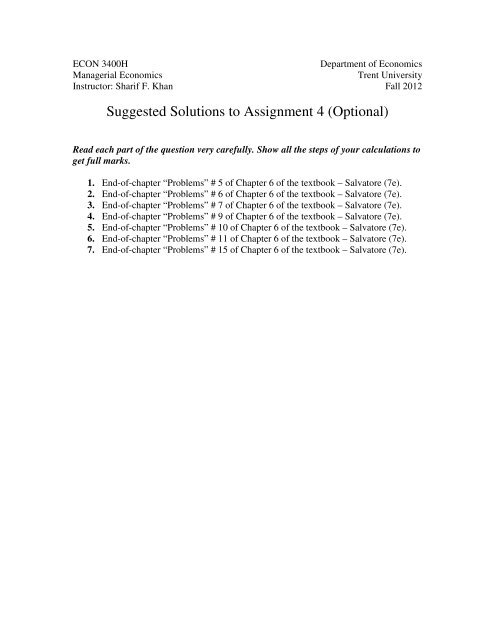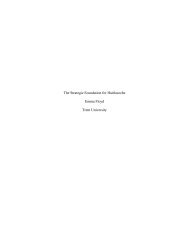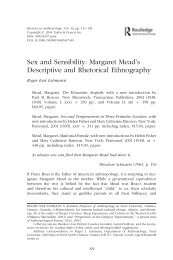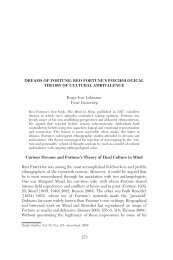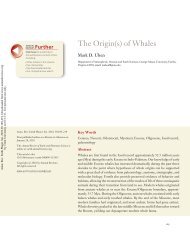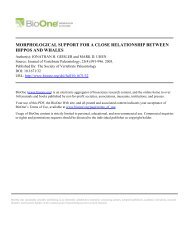Suggested Solutions to Assignment 4 (Optional) - Trent University
Suggested Solutions to Assignment 4 (Optional) - Trent University
Suggested Solutions to Assignment 4 (Optional) - Trent University
Create successful ePaper yourself
Turn your PDF publications into a flip-book with our unique Google optimized e-Paper software.
ECON 3400H<br />
Managerial Economics<br />
Instruc<strong>to</strong>r: Sharif F. Khan<br />
Department of Economics<br />
<strong>Trent</strong> <strong>University</strong><br />
Fall 2012<br />
<strong>Suggested</strong> <strong>Solutions</strong> <strong>to</strong> <strong>Assignment</strong> 4 (<strong>Optional</strong>)<br />
Read each part of the question very carefully. Show all the steps of your calculations <strong>to</strong><br />
get full marks.<br />
1. End-of-chapter “Problems” # 5 of Chapter 6 of the textbook – Salva<strong>to</strong>re (7e).<br />
2. End-of-chapter “Problems” # 6 of Chapter 6 of the textbook – Salva<strong>to</strong>re (7e).<br />
3. End-of-chapter “Problems” # 7 of Chapter 6 of the textbook – Salva<strong>to</strong>re (7e).<br />
4. End-of-chapter “Problems” # 9 of Chapter 6 of the textbook – Salva<strong>to</strong>re (7e).<br />
5. End-of-chapter “Problems” # 10 of Chapter 6 of the textbook – Salva<strong>to</strong>re (7e).<br />
6. End-of-chapter “Problems” # 11 of Chapter 6 of the textbook – Salva<strong>to</strong>re (7e).<br />
7. End-of-chapter “Problems” # 15 of Chapter 6 of the textbook – Salva<strong>to</strong>re (7e).
Table 2<br />
Number of New-Housing Starts in the<br />
United States in Each Year, 2005–2009<br />
(in thousands of units)<br />
Year<br />
New-Housing Starts<br />
2005 2,068.3<br />
2006 1,800.9<br />
2007 1,355.0<br />
2008 905.5<br />
2009 553.8<br />
5. Since the problem asks <strong>to</strong> forecast the index of new housing starts for 1998 and compare<br />
it <strong>to</strong> the index of 163 already known, we only forecast the index for 1998 without the<br />
need <strong>to</strong> forecast the index for all previous years.<br />
The only reason for forecasting all previous years would be <strong>to</strong> calculate the root-meansquare<br />
error (RMSE) of the forecast obtained with different moving averages so as <strong>to</strong> be<br />
able <strong>to</strong> choose the forecast of the moving average with the smallest RMSE. Since we<br />
know here the actual value of the index for 1998, we can compare our results directly<br />
with the actual index rather than using RMSE.<br />
The three-year moving average index of new housing starts in the United States for 1998<br />
is obtained by summing the indexes from 1995, 1996, and 1997 and dividing by 3. This<br />
is (142 + 156 + 162)/3 = 460/3 = 153.3 or 153.<br />
On the other hand, the five-year moving average is obtained by summing the indexes for<br />
the five years from 1993 <strong>to</strong> 1997 and dividing by 5. This is (125 + 146 + 142 + 156<br />
+ 162)/5 = 731/5 = 146.2 or 146.<br />
Neither the three-year nor the five-year moving average provides a good forecast for<br />
the actual index of 163 for 1998, but the three-year moving average is somewhat better.<br />
In fact, the RMSE for the three-year moving average is 17, while the RMSE for the<br />
five-year moving average is 24.<br />
112
6. (a) The exponential forecasts (F) of new housing starts (A) in the United States for<br />
the years 1986 <strong>to</strong> 1998 with w = 0.3 and w = 0.7 are given in Table 3. They are obtained<br />
by using Equation 6-12 in the text. To get the analysis started, we let F 1986 = 128<br />
(the average of the actual index of housing starts between 1986 and 1997).<br />
(b) From Table 3 we see that F 1998 = 145 with w = 0.3 and 159 with w = 0.7. Since A 1998 = 163,<br />
the exponential forecast with w = 0.7 is better.<br />
With w = 0.3, RMSE = 3 ,369 /12 = 17 and with w = 0.7, RMSE = 1 ,834 /12 = 12 .<br />
Since the RMSE with w = 0.7 is smaller than the RMSE with w = 0.3, the former gives,<br />
on the average, a better forecast.<br />
Table 3<br />
Exponential Forecasts of Index of New-Housing Starts in the United States for 1986–1997<br />
(1)<br />
Year<br />
(2)<br />
A<br />
(3)<br />
F with w = 0.3<br />
(4)<br />
A − F<br />
(5)<br />
(A −F) 2 (6) F<br />
with w = 0.7<br />
(7)<br />
A −F<br />
(8)<br />
(A − F) 2<br />
1986 116 128 −12 144 128 −12 144<br />
1987 122 124 −2 4 120 2 4<br />
1988 121 123 −2 4 121 0 0<br />
1989 121 122 −1 1 121 0 0<br />
1990 111 122 −11 121 121 −10 100<br />
1991 97 119 −22 484 114 −17 281<br />
1992 113 112 1 1 102 11 121<br />
1993 125 112 13 169 110 15 225<br />
1994 146 116 30 900 121 25 625<br />
1995 142 125 17 289 139 3 9<br />
1996 156 130 26 676 141 15 225<br />
1997 162 138 24 576<br />
3,369<br />
1998 145 159<br />
152 10 100<br />
1,834<br />
113
7. The composite index is obtained by calculating the percentage change for each series<br />
relative <strong>to</strong> the base month and then averaging these percentage changes. The percentage<br />
change from the first <strong>to</strong> the second month is 10 for indica<strong>to</strong>r A, 15 for indica<strong>to</strong>r B, and<br />
−10 for indica<strong>to</strong>r C. Their simple average (since each indica<strong>to</strong>r is given equal weight)<br />
is 5 percent. Taking the first month as the base period with a composite index of 100,<br />
we obtain the composite index of 105 for the second month.<br />
For the third month, the change of each indica<strong>to</strong>r from the base period is 20 percent, 10<br />
percent, and 10 percent, respectively, with an average of 13.3 percent. Adding this value<br />
<strong>to</strong> 100 (the base-period value of the composite index), we get the composite index of 113.33<br />
for the third month. These composite indexes are shown in the second column of Table 4.<br />
Since two indica<strong>to</strong>rs rise and one falls from the first <strong>to</strong> the second period, the diffusion index<br />
for the second period is 66.7 percent. On the other hand, since all three indica<strong>to</strong>rs rise from<br />
the second <strong>to</strong> the third month, the diffusion index for the third month is 100 percent. These<br />
diffusion indexes are shown in the third column of Table 4.<br />
Thus, according <strong>to</strong> the composite and diffusion indexes, the level of economic activity<br />
should improve in future months.<br />
Table 4<br />
Month<br />
Composite<br />
Index<br />
Diffusion<br />
Index<br />
1 100.00 —<br />
2 105.00 66.70<br />
3 113.33 100.00<br />
8. (a) Time series A is a coincident indica<strong>to</strong>r of the index series of cereal sales of the Tasty<br />
Food Company. The reason for this is that series A moves in step or coincidentally<br />
with the time series of the sales index. When the time series of the sales index rises,<br />
series A rises, and when the sales index falls, series A also falls in the same month.<br />
(b) Time series B is a leading indica<strong>to</strong>r of the index of cereal sales. That is, series B<br />
anticipates or leads changes in the direction of the sales index and can, therefore, be<br />
used <strong>to</strong> forecast changes in the firm's sales index. The lead time is two months.<br />
For example, the decline in the sales index between the third and fourth month is<br />
anticipated and can be forecasted from the decline in the value of time series B from<br />
the first <strong>to</strong> the second month. Similarly, the rise in the index of cereal sales in the fifth<br />
month can be forecasted by the rise in the value of series B in the third month, and so on.<br />
114
(c) Time series C is a lagging indica<strong>to</strong>r of the index of cereal sales. That is, series C follows<br />
or lags the changes in the direction of the sales index. The lag time is one month.<br />
For example, the increase in the sales index between the first and the second month<br />
is followed by the increase in series C from the second <strong>to</strong> the third month. Similarly,<br />
the decline in the sales index in the third month is followed by the decline in series<br />
C in the fourth month, and so on.<br />
9. (a) By substituting the given values of the independent or explana<strong>to</strong>ry variables and t = 24<br />
for 1972 in the estimated demand equation, we get the quantity demanded (sales) of<br />
sweet pota<strong>to</strong>es in the United States in 1972 of<br />
QD s = 7,609 − 1,606(4.10) + 59(208.78) + 947(3.19) + 479(2.41) − 271(24)<br />
= 11,013.74 in thousands (11.01 millions) hundredweight.<br />
(b) By substituting the given values of the independent or explana<strong>to</strong>ry variables and t = 25<br />
for 1973 in the estimated demand equation, we get the quantity demanded (sales) of<br />
sweet pota<strong>to</strong>es in the United States in 1973 of<br />
QD s = 7,609 − 1,606(4.00) + 59(210.90) + 947(3.55) + 479(2.40) − 271(25)<br />
= 11,364.55 in thousands (11.36 millions) hundredweight<br />
Of course, the accuracy of these results depends on the accuracy of the forecasted<br />
values of the independent or explana<strong>to</strong>ry variables. The greater the errors in<br />
forecasting the latter, the greater will be the forecasting error in the former.<br />
10. (a) By substituting the given values of the independent or explana<strong>to</strong>ry variables and<br />
D = 1 (a postwar year) for 1962 in the estimated demand equation, we get the per<br />
capita personal consumption expenditures on shoes of<br />
D t = 19.575 − 0.0923(20) + 0.0289(1,646) − 99.569(0.4) − 4.06(1)<br />
= $21.41 at 1954 prices<br />
(b) By substituting the given values of the independent or explana<strong>to</strong>ry variables and<br />
D = 1 (a postwar year) for 1972 in the estimated demand equation, we get the per<br />
capita personal consumption expenditures on shoes of<br />
D t = 19.575 − 0.0923(30) + 0.0289(2,236) − 99.568(0.6) − 4.06(1)<br />
= $17.63 at 1954 prices<br />
It seems that real per capita personal consumption expenditures declined over<br />
time as people used au<strong>to</strong>mobiles more and walked less (a change in taste).<br />
(c) We would expect the error for the 1972 forecast <strong>to</strong> be larger than for the 1962<br />
forecast. The reason is that the further in<strong>to</strong> the future the dependent variable<br />
115
is forecasted, the more the estimated regression equation is likely <strong>to</strong> lead <strong>to</strong><br />
error because it does not reflect the structural changes (i.e., changes in the values<br />
of the estimated coefficients) that usually occur over time.<br />
11. (a) The reduced-form equation for C t is obtained by substituting Equation 6-23 for GNP t<br />
in<strong>to</strong> Equation 6-21 for C t . That is:<br />
Substituting Equation 6-23 for GNP t in<strong>to</strong> Equation 6-21 for C t (and omitting u 1t<br />
because its expected value is zero), we get<br />
C t = a 1 + b 1 (C t + I t + G t )<br />
(6-24')<br />
C t = a 1 + b 1 C t + b 1 I t + b 1 G t (6-24")<br />
By then substituting Equation 6-22 for I t in<strong>to</strong> Equation 6-24" (and omitting u 2t ), we have<br />
C t = a 1 + b 1 C t + b 1 (a 2 + b 2 FS) + b 1 G t<br />
(6-25')<br />
C t = a 1 + b 1 C t + b 1 a 2 + b 1 b 2 π t − 1 + b 1 G t (6-25")<br />
Collecting the C t terms <strong>to</strong> the left in Equation 6-25" and isolating C t , we have<br />
C t (1 − b 1 ) = a 1 + b 1 a 2 + b 1 b 2 π t − 1 + b 1 G t<br />
(6-26')<br />
Dividing both sides of Equation 6-26' by 1 − b 1 , we finally obtain<br />
C t = a 1 + b 1 a 2 + b 1 b 2 π t − 1 + b 1 G t (6-27')<br />
1 − b 1 1 − b 1 1 − b 1 1 − b 1<br />
Equation 6-27' is the reduced-form equation for C t . It is expressed only in terms<br />
of π t − 1 and G t (the exogenous variables of the model) and can be used in forecasting<br />
C t + 1 by substituting the known value of π t and the predicted value of G t+1 in<strong>to</strong><br />
Equation 6-27' and solving for C t + 1 .<br />
(b) Equation 6-22 is already in reduced form because π t − 1 is exogenous (i.e., it is<br />
known in period t). The lagged (and therefore known) value of a variable is<br />
sometimes known as a predetermined variable.<br />
12. Wait for June 2011 when the 2011/1 issue of the OECD Economic Outlook will be out and<br />
compare the forecasts presented in Table 6-10 in the text with the actual results reported<br />
for 2010 in June 2011.<br />
13. Prepare a table similar <strong>to</strong> Table 6-10 in the text of the macroforecasts in the 2011/2 issue of<br />
the OECD Economic Outlook.<br />
116
14. (a) Wait for June 2012 when the 2012/1 issue of the OECD Economic Outlook is out and<br />
compare the forecast presented in the table that you prepared for Problem 13 with the actual<br />
results reported in the 2012/1 issue of the OECD Economic Outlook.<br />
(b) Compare the accuracy of the forecasts in your answer <strong>to</strong> Problem 12 with your answer <strong>to</strong><br />
part (a) of this problem. The accuracy of the forecasts for 2011 will be better than for those<br />
for 2010 if economic conditions were more stable in 2011 than in 2010. It is easier <strong>to</strong> forecast<br />
the level of economic activity when economic conditions are stable than when they are<br />
less stable or unsettled.<br />
15. (a) For ease of reference, the estimated regression and the meaning of the variables are<br />
repeated below:<br />
ln Q t = 1.2789 − 0.1647 ln P t + 0.5115 ln Y t + 0.1483 ln P' t − 0.0089t<br />
(−2.14) (1.23) (0.55) (−3.36)<br />
− 0.0961 D 1t − 0.1570 D 2t − 0.0097 D 3t<br />
(−3.74) (−6.03) (−0.37)<br />
R 2 = 0.80 D–W = 2.08<br />
where<br />
Q t = quantity (in pounds) of coffee consumed per capita (for population over 16) in quarter t<br />
P t = relative price of coffee per pound in quarter t, at 1967 prices<br />
Y t = per capita disposable personal income in quarter t, in thousands of 1967 dollars<br />
P' t = relative price of tea per quarter pound in quarter t, at 1967 prices<br />
t = time trend; t = 1 for first quarter of 1963 <strong>to</strong> t = 58 for second quarter of 1977<br />
D 1t = dummy variable equal <strong>to</strong> 1 for first quarter (spring) and 0 otherwise<br />
D 2t = dummy variable equal <strong>to</strong> 1 for second quarter (summer) and 0 otherwise<br />
D 3t = dummy variable equal <strong>to</strong> 1 for third quarter (fall) and 0 otherwise<br />
and the numbers in parentheses below the estimated coefficients are values of the t statistic.<br />
Since the above equation is expressed in terms of logarithms, the first step in the solution<br />
is <strong>to</strong> change all the predicted values of the independent or explana<strong>to</strong>ry variables (except the<br />
dummy variables and t) in<strong>to</strong> their natural logs. These are shown in Table 5.<br />
117
Table 5<br />
Quarter ln P Ln Y ln P'<br />
1977.3 0.62 1.27 0.10<br />
1977.4 0.55 1.28 0.08<br />
1978.1 0.47 1.29 0.07<br />
1978.2 0.38 1.30 0.05<br />
By substituting the given values of the independent or explana<strong>to</strong>ry variables,<br />
t = 59, D 3 = 1, and D 1 = D 2 = 0, for the third quarter of 1977 in the estimated<br />
demand equation, we get the third-quarter 1977 forecast of the demand for coffee of<br />
ln Q 59 = 1.2789 − 0.1647(0.62) + 0.5115(1.27) + 0.1483(0.10) − 0.0089(59)<br />
− 0.0961(0) − 0.1570(0) − 0.0097(1)<br />
ln Q 59 = 1.3064. The antilog of 1.3064 is 3.69 lb.<br />
This is the forecasted number of pounds of coffee consumed per capita for the<br />
population over age 16 in the third quarter of 1977.<br />
(b) By substituting the given values of the independent or explana<strong>to</strong>ry variables, t = 60<br />
and D 1 = D 2 = D 3 = 0, for the fourth quarter of 1977 in the estimated demand<br />
equation, we get the fourth-quarter 1977 forecast of the demand for coffee of<br />
ln Q 60 = 1.2789 − 0.1647(0.55) + 0.5115(1.28) + 0.1483(0.08) − 0.0089(60)<br />
− 0.0961(0) − 0.1570(0) − 0.0097(0)<br />
ln Q 60 = 1.3209. The antilog of 1.3209 is 3.75 lb.<br />
This is the forecasted number of pounds of coffee consumed per capita for the population<br />
over age 16 in the fourth quarter of 1977.<br />
(c) By substituting the given values of the independent or explana<strong>to</strong>ry variables, t = 61,<br />
D 1 = 1, and D 2 = D 3 = 0, for the first quarter of 1978 in the estimated demand<br />
equation, we get the first-quarter 1978 forecast of the demand for coffee of<br />
118
ln Q 61 = 1.2789 − 0.1647(0.47) + 0.5115(1.29) + 0.1483(0.07) − 0.0089(61)<br />
− 0.0961(1) − 0.1570(0) − 0.0097(0)<br />
ln Q 61 = 1.2327. The antilog of 1.2312 is 3.43 lb.<br />
This is the forecasted number of pounds of coffee consumed per capita for the<br />
population over age 16 in the first quarter of 1978.<br />
(d) By substituting the given values of the independent or explana<strong>to</strong>ry variables,<br />
t = 62, D 1 = D 3 = 0, and D 2 = 1, for the second quarter of 1978 in the estimated<br />
demand equation, we get the second-quarter 1978 forecast of the demand for coffee<br />
ln Q 62 = 1.2789 − 0.1647(0.38) + 0.5115(1.30) + 0.1483(0.05) − 0.0089(62)<br />
− 0.0961(0) − 0.1570(1) − 0.0097(0)<br />
ln Q 62 = 1.1799. The antilog of 1.1799 is 3.25 lb.<br />
This is the forecasted number of pounds of coffee consumed per capita for the<br />
population over age 16 in the second quarter of 1978.<br />
(e) Since the estimated regression equation seems <strong>to</strong> fit the data reasonably well (it<br />
explains 80 percent of the variation in Q t ) and we are using it <strong>to</strong> forecast Q t for<br />
the next four quarters only, we can be reasonably confident in our forecast.<br />
A sudden and unforeseen change in tastes (due, for example, <strong>to</strong> the finding that coffee<br />
causes heart ailments) could cause the forecasted error <strong>to</strong> become very large. In that<br />
case, the regression equation would have <strong>to</strong> be reestimated <strong>to</strong> reflect this structural<br />
change before we could use it <strong>to</strong> generate forecasts in which we could have a great<br />
deal of confidence.<br />
119


